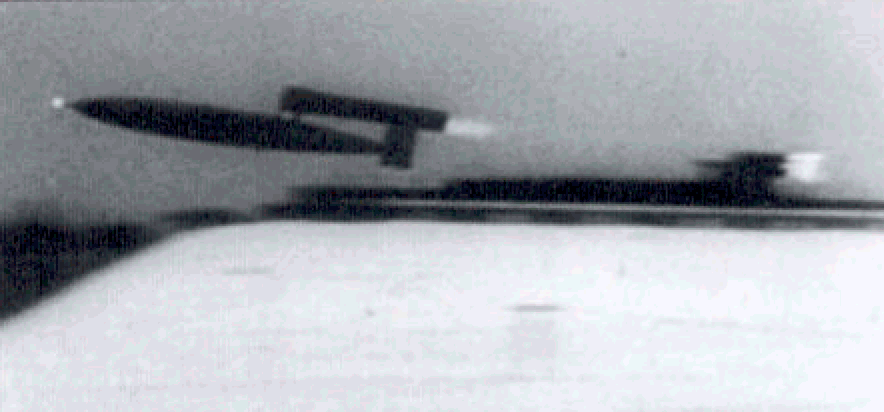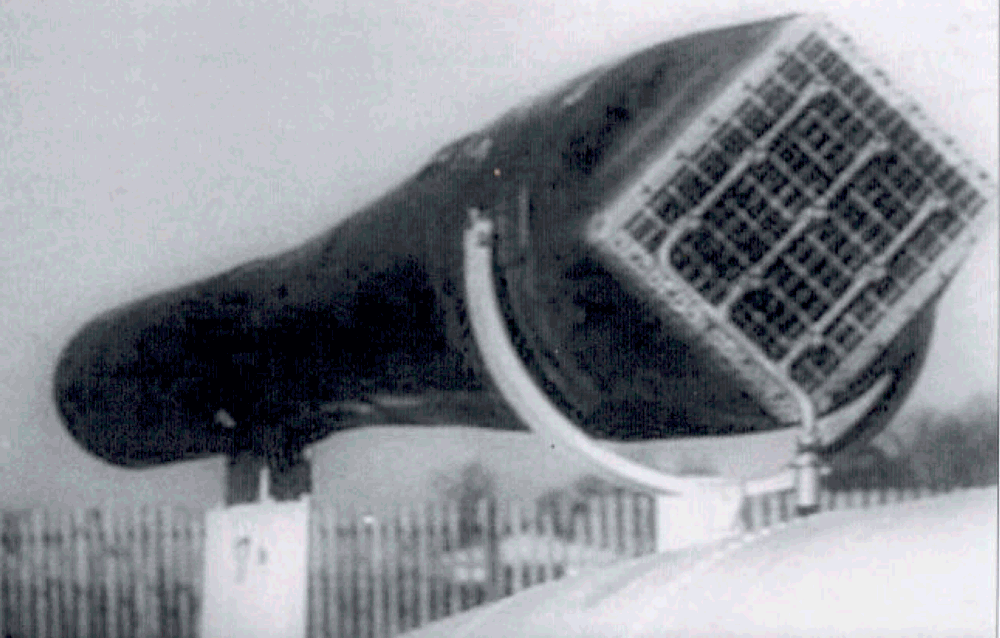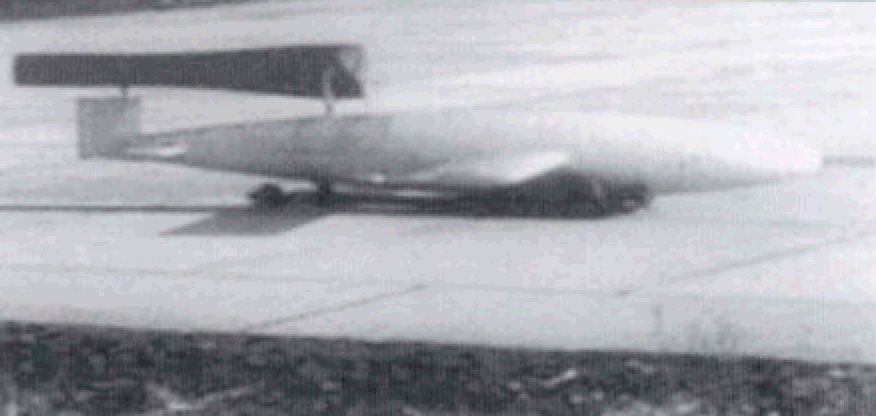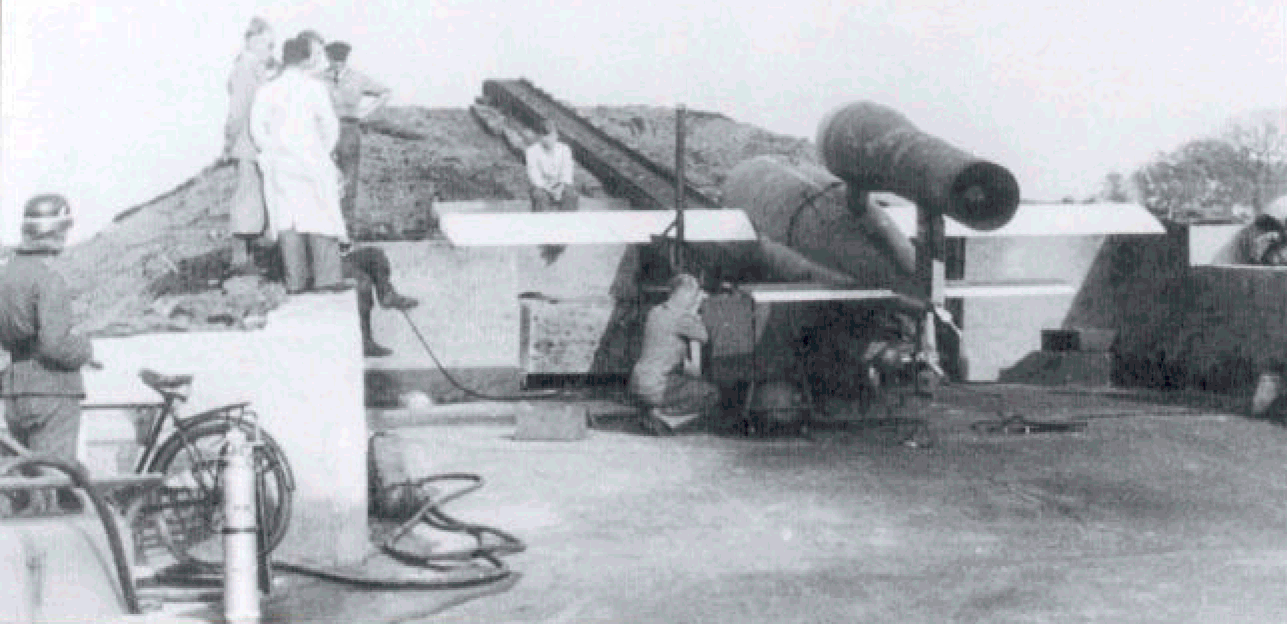
STEVEN J. ZALOGA, illustrated by JIM LAURIER
V-1 FLYING BOMB. 1942-52. HITLER'S INFAMOUS "DOODLEBUG"
V-1 FLYING BOMB 1942-52: HITLER'S INFAMOUS "DOODLEBUG"

A wartime German propaganda photo purporting to show a V-1 launch. V-1 was only one of a number of names given to the Fieseler Fi-103 cruise missile during the course of its brief combat career. (USAOM-APG)
The V-1 flying bomb was the most widely used guided missile of World War II and the world's first successful cruise missile. In comparison to its wartime stable-mate, the V-2 ballistic missile, the V-1 was significantly simpler, easier to manufacture, and more practical to operate in combat conditions. It was employed for terror attacks against London, Antwerp and other European cities, causing tens of thousands of civilian casualties. But its technical shortcomings and vigorous Allied counter- measures prevented it from fulfilling its mission. (Copies of the V-1 were manufactured by the United States, the Soviet Union, and France, but it was rapidly overtaken by more advanced missile designs in the 1950s.
The idea of converting a small airplane into a pilotless flying bomb is nearly as old as military aviation. In 1915, the Sperry Gyroscope Co. in the United States experimented with "aerial torpedoes" using gyroscopes to guide a small aircraft. Britain followed suit, with weapons such as the Larynx flying bomb launched from HMS Stronghold during trials in 1927. None of these missiles proved practical, but little-known propeller-driven flying bombs remained in development by the US Navy well into World War II.
The most significant German innovation in flying bombs was to use a jet engine. Paul Schmidt was a pioneer of early pulse-jet engines and he was quick to realize that such a simple and inexpensive powerplant would be ideal for a missile. In 1935 he offered a design to the Luftwaffe which he had conceived with Prof. G. Madelung. His flying bomb was ahead of its time, including among its features a novel mid-fuselage air intake. The Luftwaffe, however, rejected the project as "technically dubious and uninteresting from the tactical viewpoint."

V-1 ancestors. (Author)
Entirely separately from these ventures, Dr Fritz Gosslau of the Argus Motor Works in Berlin developed the FZG-43 (Flakzielgerat-43, Anti-aircraft Target Device 43) which was a remote control model airplane for use as a target drone by Luftwaffe anti-aircraft crews. In October 1939 Argus proposed a more ambitious scheme using a larger radio-controlled aircraft dubbed Fernfeuer ("Deep Fire"). It could carry a one-ton bomb-load, and would be controlled by a piloted version of the same aircraft. On delivering its bomb, the Fernfeuer would return to base. This was not a cruise missile like the Schmidt design, but rather an ancestor of today's UCAV (uninhabited combat air vehicle). The Luftwaffe was intrigued by the idea, and Argus worked with other firms including the Lorenz guidance company and the Arado aircraft firm to perfect the idea. However, attempts to win a contract to develop the Fernfeuer in 1940-41 were rebuffed by the Luftwaffe. Although the Luftwaffe was sponsoring a number of projects to develop precision attack missiles, such as the Henschel Hs-293 anti-ship missile, there was no enthusiasm for area bombardment missiles.
In 1941 the efforts of Gosslau and Schmidt began to converge. Argus was primarily an aircraft engine firm, and since 1939 had been working on pulse-jet engine designs independently of Schmidt. Pulse-jets are an earlier, and significantly different, type of engine from the later and more successful turbojet. The first primitive pulse-jet engines had been studied its early as 1908 but did not reach maturity until the 1940s. In a pulse-jet engine, fuel is injected into a combustion chamber where it is mixed with air and then ignited, with the resulting jet exhaust directed back through an exhaust tube. Early studies showed that, under ideal conditions, the combustion cycle could be self-sustaining since secondary shock waves returning to the combustion chamber could be used to ignite subsequent pulses. Nevertheless, there was the need for a practical technique to prevent the jet pulse from also exiting through the air intake at the front of the engine.
In 1940 the Luftwaffe encouraged Schmidt and Argus to cooperate in the hopes of developing a practical design. Schmidt's innovation was a simple but effective shutter system that allowed air to enter the combustion chamber, but which automatically closed when the fuel detonated, forcing the energy back out the exhaust tube. This method was superior to the approaches being studied by Argus, and was incorporated into their next design in late 1940.

The heart of the Argus-Schmidt pulse-jet was this complicated matrix of varies and fuel injectors located at the front of the engine. A mixture of compressed air (1) and fuel (2) was injected into the combustion chamber through nozzles (3) mounted in assemblies (4). The spring steel shutters (6) were mounted to carrier plates (5) and allowed in air to start the detonation process, but prevented the exhaust from exiting the front of the engine. (MHI)
In the meantime Argus had developed an innovative method of injecting atomized fuel into the combustion chamber which permit ted a stable combustion sequence. The resulting Argus-Schmidt engine design was remarkably simple and cheap compared to the rival turbo-jets, and had an excellent power-to-weight ratio. On the other hand, it had several significant drawbacks: it was not fuel efficient and a resonating engine with combustion detonations occurring several dozen times per second caused physical damage to the airframe.
Argus began testing its new pulse-jet engine on automobiles in January 1941, and it first flew on a Gotha 145 biplane on April 30th, 1941. It was promising enough that the Luftwaffe supported further research on more substantial aircraft. Gosslau was intrigued by the idea of using it to power a flying bomb, but Argus lacked an experienced airframe designer. A Fieseler engineer, Robert Lusser, visited Argus on February 27th, 1942, and Gosslau proposed a cooperative effort between Argus and Fieseler on a flying bomb. Gosslau sketched a simple aircraft with a pulse-jet under each wing. Lusser instead sketched an alternative idea with a single pulse jet mounted above the tail. This brief meeting was the genesis of the V-1 flying bomb.
Lusser completed a preliminary design at the end of April 1942. Radar or radio command systems were possible guidance options, but these were quickly rejected since the Allies could develop electronic counter-measures. Instead, the Germans turned to inertial guidance based on gyroscopes, as pioneered by Sperry in 1915. The proposed P35 Erfurt would have a range of 300km (186 miles) with a half-ton warhead and a speed of 700km/hr (435mph). When submitted to the Luftwaffe on June 5th, 1942, the Erfurt found a much more receptive audience than in years past. The attitude of the senior Luftwaffe leadership towards area bombardment weapons had changed due to the declining strategic situation. Britain had begun systematic heavy bomber attacks against Germany in March 1942, and Hitler demanded retaliatory strikes against England. The Luftwaffe lacked a heavy bomber force due to delays in its Heinkel He-177 program. Furthermore, the German Army was muscling in on the strategic bombardment mission with its A-4 ballistic missile program, better known by its later propaganda name, V-2. The Army attempted to win Hitler's support for the A-4 ballistic missile program by pointing out that it would succeed where the Luftwaffe had failed in the 1940 Battle of Britain. This insult was the last straw and, for the prestige of the service, the senior Luftwaffe leadership decided they needed a missile program of their own. The project was approved on June 19th, 1942, and incorporated into the Vulkan ("Volcano") program, which managed Luftwaffe missile efforts. Internally at Fieseler, the P35 was renamed in the standard fashion as the Fieseler Fi-103. The Luftwaffe assigned it the code name Kirschkem ("Cherry Stone"). It was later given another cover-name, FZG-76 (Flakuelgerat 76), linking it to the innocuous Argus FZG-43 target drone.

The first powered launch was conducted from an Fw-200 Kondor bomber over the Baltic on December 10th, 1942, using FM03V7. Note that some early airframes had an unusual vertical rudder in front of the pulse-jet engine. (DAVA)
Argus remained in charge of the pulse-jet engine, now designated as the Argus AS 109-014. The guidance system was entrusted to the Askania company in Berlin which was already involved in the development of inertial guidance systems for other Luftwaffe missiles. Rheinmetall-Borsig developed a rail launcher using a rocket sled to launch the Kirschkem.
The first Fi-103 was completed on August 30th, 1942. It differed from the original Erfurt design in numerous respects including the use of a single rudder instead of a twin tail. A refined version of the Argus pulse- jet was completed in September 1942 and began flight trials. Failure of the high-speed flight trials nearly led to the program's termination, but these problems were gradually overcome after it was realized that many of the anomalous test results were due to the peculiar effects produced by pulse-jets during wind-tunnel tests.
While the problems with the engine were being sorted out, the first flight tests of the Kirschkem were attempted by the Luftwaffe Test Establishment at Karlshagen at Peenemünde-West, near the A-4/V-2 ballistic missile test site. The first unpowered flight was conducted from an Fw-200 Kondor bomber on October 28th, 1942. The missile proved to be well designed and very stable in flight. The first powered test was conducted on December 10th, 1942, with Fi-103V7, the V7 indicating the seventh test (Versuch) airframe.

This test film from the launch of FM03V6 on January 13th, 1943, shows the use of the initial Rheinmetall-Borsig rocket sled. The early missiles had a deeper rudder which extended below the fuselage as seen here. (DAVA)
A launch site for the Rheinmetall-Borsig catapult was established at Peenemünde pointing out eastward along the Baltic coast. The first catapult test was conducted on October 20th, 1942, using a concrete ballistic dummy, followed by the test of a fuselage and Argus powerplant, minus the wings. The first powered launch followed on December 24th, 1942, with Fi-103V12. The flying bomb flew for about a minute and reached speeds of 500km/hr (310mph) before crashing into the Baltic. Although far short of its design specifications, this was an important milestone which led to approval for full-scale development.

The early test missiles had an exposed pulse-jet frame and external engine yoke support as seen here on Fi-103V17. A cowl was later added to channel the airflow. (DAVA)
Due to the urgency of the program, the testing of the airframe, pulse-jet, guidance, and launch catapult were conducted in parallel. This created some significant problems, since in the event of crashes or other failures, it was often impossible to determine which of the sub-systems had been responsible for the problem. Shortcomings of the Rheinmetall-Borsig launcher led to an alternative catapult being designed in early 1943, the Hellmuth Walter Werke (HWW) Schlitzrohrschleuder (split-tube catapult). The Walter design used a gas generator powered by a combination of T-stoff (hydrogen peroxide) and Z-stoff (sodium permanganate) rocket fuel. It worked much like a modern aircraft carrier steam catapult: high pressure gas was pumped into a tube inside the launch rail box that propelled a piston, connected underneath the Fi-103.

The early V-zellen prototype missiles, such as FM03V17 seen here, had a somewhat sleeker shape than the production missiles, and many small detail differences. The probe on the nose contained a flare used in tracking the missile after launch. This particular missile was launched on March 11th, 1943. (DAVA)
The test program was plagued by crashes, many induced by the pulse- jet engine. The fuel detonated inside the engine 47 times per second, creating an enormous amount of noise and vibration that could literally shake the fuselage and wings to pieces. The most common problem was the disintegration of the shutters in the front of the pulse-jet, upsetting the air flow into the engine if enough failed. Through the end of July 1943, 84 Fi-103 flying bombs had been launched, 16 from the air and 68 from ground catapults. Of the catapult launches, only 28 had been successful. About a third of the missiles failed to launch, or after leaving the catapult, rolled and crashed into the Baltic seconds later. None of the missiles had yet been fitted with the full guidance system, which was still in development, nor had any been launched at lull combat weight as the Walter catapult was still not ready. On a more positive note, at least one Fi-103 had attained speeds of 625km/hr (390mph), and had reached distances of 225km (140 miles).

The unsuccessful Rheinmetall-Borsig launcher was replaced by a Walter design and the first prototype is seen here during trials in the autumn of 1943. (NARA)
Trials with the new Askania autopilot guidance system began in the summer of 1943. A magnetic compass served as the azimuth control, keeping the missile heading along a predetermined magnetic bearing to the target. A pair of gyroscopes monitored yaw and pitch, while a barometric device monitored the altitude. A small propeller on the nose of the missile was linked to an air-log which measured the distance that the missile had traveled. The autopilot was preset prior to launch regarding the missile's cruising altitude and target range, while the azimuth was determined by the orientation of the launcher. Once the air log had determined that the range had been reached, two detonators fired which caused the rudder and elevators to lock, pushing the missile into a steep dive towards its target. Fieseler boasted that 90 percent of the production missiles would strike within a circle 10km (6 miles) around the target, and that half would land within a circle 6km (3.7 miles) in diameter around the target.
On Hitler's orders, a special commission was convened on May 26th, 1943, to determine whether the Luftwaffe's FZG-76 cruise missile or the Army's A-4 ballistic missile was the preferable bombardment weapon. The commission concluded that both the FZG-76 and A-4 should be manufactured since they were complementary to one another. The FZG-76 was judged to be more vulnerable to interception, but was far less expensive to manufacture and much simpler to operate; the A-4 ballistic missile was invulnerable to interception, but was very expensive to manufacture and complicated to operate. By the late summer of 1943, the Kirschkern had progressed far enough to begin plans for serial production. The original plans called for serial production to begin in August 1943 so that 5,000 missiles would be ready when combat use began on December 15th, 1943.
Among the more confusing aspects of the Fieseler flying bomb were its numerous names and codenames. As mentioned earlier, its early names included the Fieseler designation Fi-103, and the Luftwaffe cover-names FZG-76 and Kirschkern. On April 30th, 1944, Hitler ordered that FZG-76 Kirschkern be dropped in favor of Maikäfer ("June Bug"). This was one of the more short-lived names as the German propaganda ministry started using the term V-1 (VergeUungswaffe-1 - "Retaliation weapon 1") during radio broadcasts on June 23rd, 1944, and Hitler made this its official name on July 4th, 1944. V-1 lasted until November 2nd, 1944, when Hitler renamed it Krahe ("Crow").

Some of the Fi-103s were tested from aircraft, in this case an He-111 of Erprobungskommando Bannock at Karlshagen. This particular missile, FM03V83, was launched on August 22nd, 1943, and inadvertently crashed on Bornholm island. Danish resistance provided pictures of the wreckage to British intelligence, the first detailed glimpse of the new weapon. By this stage, the V-zellen missiles had the improved air intake at the front of the engine but still employed the external yoke mounting. (NARA)
In April 1943 Colonel Max Wachtel was appointed to command the first missile unit, Lehr-und-Erpmbungskommando Wachtel ("Wachtel Training and lest Command"). This unit was deployed at the Zempin test range near Peenemünde and another catapult site was built on the Baltic for training. This was the seed for the later combat unit, Flak-Regiment 155 (W), the W indicating Werfer, or "launcher", and not Wachtel as is so often reported.
There was no consensus on how best to deploy the new missiles. The Luftwaffe Flak commander, Lt. Gen. Walther von Axthelm, wanted the missiles deployed in a large number of small field bases that could be easily camouflaged. The head of the Luftwaffe production program, Field Marshal Erhard Milch, favored a small number of large bomb-proof bunkers, a position that was supported by Hitler based on the success of the heavily fortified Brest U-boat shelters in resisting Allied bomber attacks. On June 18th, 1943, Luftwaffe chief Hermann Goring held a meeting with Milch and Axthelm to settle the issue. Goring suggested a compromise: four large missile bunkers would be built, along with 96 field sites. In addition, the launch of FZG-76 missiles from bomber aircraft would also be employed. Production would start in August at a rate of 100 per month, gradually ramping up to 5,000 monthly by May 1944. Goring wanted 50,000 per month, but no sober official treated this seriously. Hitler approved the plan on June 28th, 1943, setting in motion the Kirschkern construction program.
Manufacture of the Fi-103 started months late. Initial production was scheduled to begin at the Volkswagen plant at Fallersleben and at Fieseler in Kassel-Bettenhausen in August 1943. Minister for War Production Albert Speer continued to favor the Army's A-4 missile program, and a Luftwaffe decision to emphasize fighter construction adversely impacted the FZG-76 program since it was considered a bomber-substitute. In some respects, the delay was not entirely unwelcome as the FZG-76 was still not mature. Through August 1943, only 60 percent of the test launches were successful. The early FZG-76 missiles were categorized in three batches, the V-zellen (Vorserienzellen: prototype airframes); M-zellen (Modellserienzellen: pre-production); and G-zellen (Grosserienzellen: serial production). Although 200 V-zellen had been planned, only 120 were actually completed and most had been launched by the end of the summer of 1943. By September 1943, only 38 M-zellen missiles had been delivered, and the first training launch by Wachtel's regiment did not take place until October 26th, 1943. The guidance system was still not mature. In December 1943 British intelligence decrypted the tracking reports from radar stations along the Baltic which revealed that guidance problems were still so severe that, if the FZG-76 had been launched against London as planned in December 1943, fewer than one in six would have landed in the city, even discounting premature crashes and British counter-measures.

This is FM03M23, one of the M-zellen pre-production missiles tested in the fall of 1943. (NARA)
On October 22nd, the RAF raided the Fieseler plant, shutting down its Fi-103 line. Production was further delayed by the endless stream of changes and modifications to the design. The M-zellen missiles were prone to flip over on their backs after launch due to shortcomings in the new guidance system, and the serial production G-zellen were even worse, often losing their wings after launch. The G-zellen problem was traced back to a production change between the pre-series and mass-produced missiles where spot-welding had replaced more time-consuming riveting. The new lightweight stamped-steel wing rib proved too weak and the first batch of 1,400 airframes had to be scrapped. At the end of November production was halted until the problems could be remedied. Significant production did not resume until March 1944 after the production faults had been ironed out. An Allied bombing attack on the Fallersleben plant missed the FZG-76 production line and in July FZG-76 production was started at the notorious underground Mittelwerke plant near Nordhausen since it was less vulnerable to bombing.
We have much more interesting information on this site.
Click MENU to check it out!
∎ cartalana.com© 2009-2025 ∎ mailto: cartalana@cartalana.com